Mid-block pedestrian signals are installations that stop traffic so pedestrians can cross unimpeded.
I prefer traffic signals because once the traffic has stopped and I have my green signal, I trust it is safe to go. At unsignalised intersections I have to look around all the time to check because I cannot hear anything coming. |
Mid-block pedestrian signals most commonly operate with two phases, one for vehicles, the other for pedestrians. However, they can include intelligent features, such as extending the pedestrian phase for slower pedestrians and detecting that pedestrians have already crossed prior to the pedestrian phase being displayed. Mid-block signals can also be designed to accommodate cyclists and other users.
An example of a mid-block signalised crossing for pedestrians is shown in the photo below.
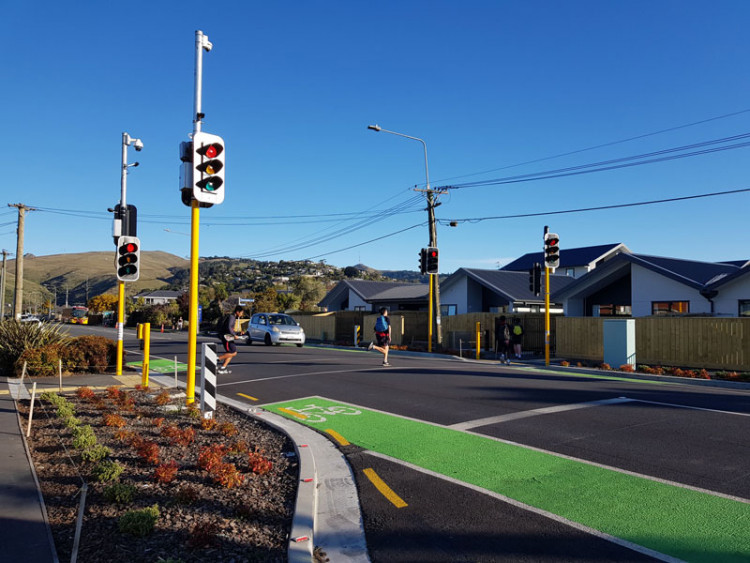
Mid-block signalised pedestrian crossing, Wilsons Road, Christchurch. (Photo: Gemma Dioni)
Check whether a signalised crossing is a suitable treatment for your site by referring to
PNG: Crossing selection process
Mid-block pedestrian signals are often the best option for multi-lane roads and on busy two-lane roads. They can be combined with kerb extensions, raised platforms and refuges.
If the number of pedestrians justifies them, consider using mid-block signals for sites with high traffic flows where the environment prevents installation of pedestrian refuges or zebra crossings with appropriate physical aids.
Pedestrian signals are usually installed where there are enough pedestrians to ensure the signals are activated regularly. If the signals are not activated regularly, drivers can develop the expectation that pedestrians will not be crossing, leading to safety issues. The alternative may be to signalise a nearby intersection.
There may be locations where, due to a desire to encourage pedestrian priority, a signalised crossing may be appropriate with lower than normal pedestrian flows. In such circumstances, it may be appropriate to introduce additional crossing elements to enhance the visibility and likely driver compliance with the crossing, for example raised platforms, pedestrian refuges and overhead mast arms.
PNG: Pedestrian / median refuges
There are several different types of mid-block signalised crossings, these include:
More information about each of these signalised crossing types are described in the following sections.
The standard pedestrian only signals are the most common form of mid-block signalised crossing for pedestrians. It uses far side signal displays that are visible to the pedestrian waiting to cross the road. People activate the crossing by pushing the button. An example of standard pedestrian only signals is shown in the photo below.
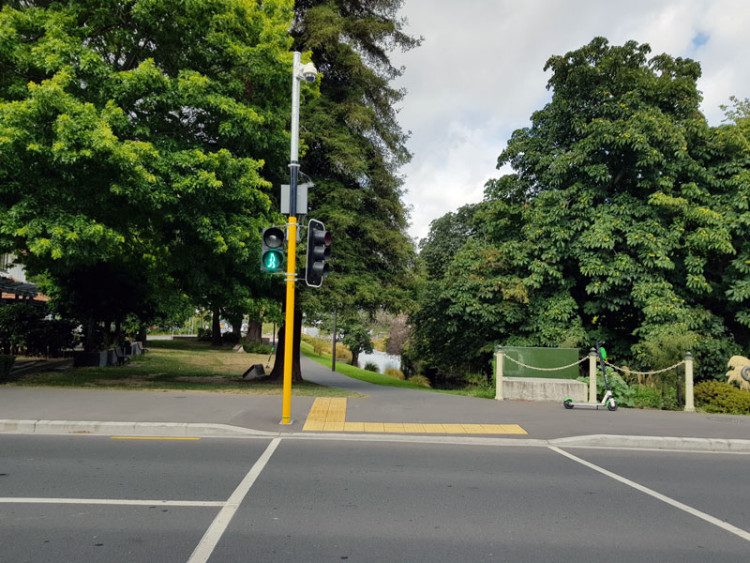
Pedestrian-only signal display. (Photo: Gemma Dioni)
Two-stage signalised crossings are commonly used when the carriageway is particularly wide (usually over 15 metres and median divided), and where people may have difficulty crossing in one stage. An example of a two-stage crossing is shown in the photo. The table below provides additional considerations for a two-stage crossing.
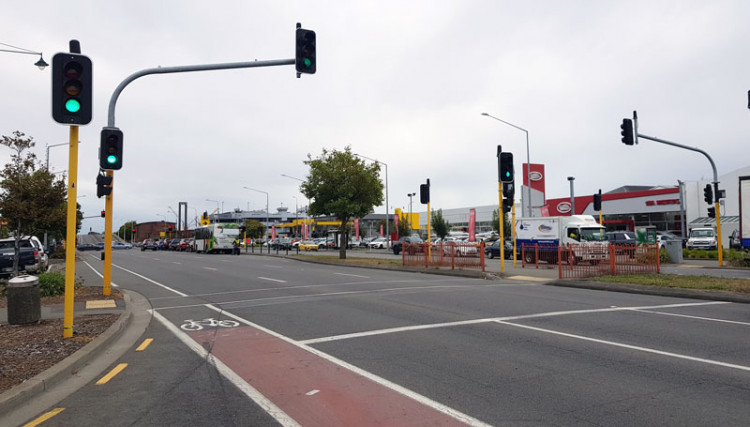
two-stage crossing for pedestrians. (Photo: Gemma Dioni)
Table: Advantages and disadvantages of two-stage pedestrian crossings
|
Advantages |
Disadvantages |
|
Central island breaks up the crossing distance for people crossing the road. |
Greater space required to provide sufficiently large central island for people to wait safely. |
|
Can reduce traffic delays as the crossing is split and can be operated as two separate crossings. |
Requires pedestrians to cross in two-stages which can result in increased waiting times . |
|
Separate crossings increase flexibility – pedestrians may get more opportunities to cross per signal cycle and waiting time may decrease. |
Walking distances increase. If there is a more direct crossing available nearby (eg cycle crossing) then pedestrians may not use the two-stage crossing. |
The design should include detection and a call button for pedestrians in the median to ensure they are not trapped there.
Countdown timers are an optional addition to the crossing. The pedestrian signals operate the same as a standard crossing however during the clearance phase (when the flashing red human figure symbol is displayed), an additional countdown ‘clock’ showing the number of seconds remaining in the pedestrian phase is displayed. Countdown timers can only be used with fixed pedestrian clearance times and not variable clearance times.
People activate the crossing by pushing the button. To reduce delay to drivers, some crossings use kerb-side detectors that cancel the call if the pedestrians move out of the detector area, ie away from the crossing. An example of countdown timers at pedestrian only signals is shown in the photo below.

Pedestrian only signal display with countdown timer. (Photo: Gemma Dioni)
Nearside signals show the pedestrian display on the nearside rather than the far side of the street. These are similar to PUFFIN crossings [2] however they are not defined as such in NZ. The pedestrian phase is activated by pushing the button. The nearside display is mounted next to pedestrians waiting on the footpath and orientated so that people crossing can see approaching vehicles and the display to see their pedestrian phase called. Unlike the standard signal controlled mid-block crossing there is only a steady red and green walking human figure symbol displayed, with no flashing red standing human figure symbol displayed.
In terms of detection, the nearside crossing uses kerb side detectors that cancel the call from the pedestrian button if the pedestrian moves away from the detector area, and on-road detection can lengthen the clearance period if required. An example of nearside pedestrian signals is shown below.
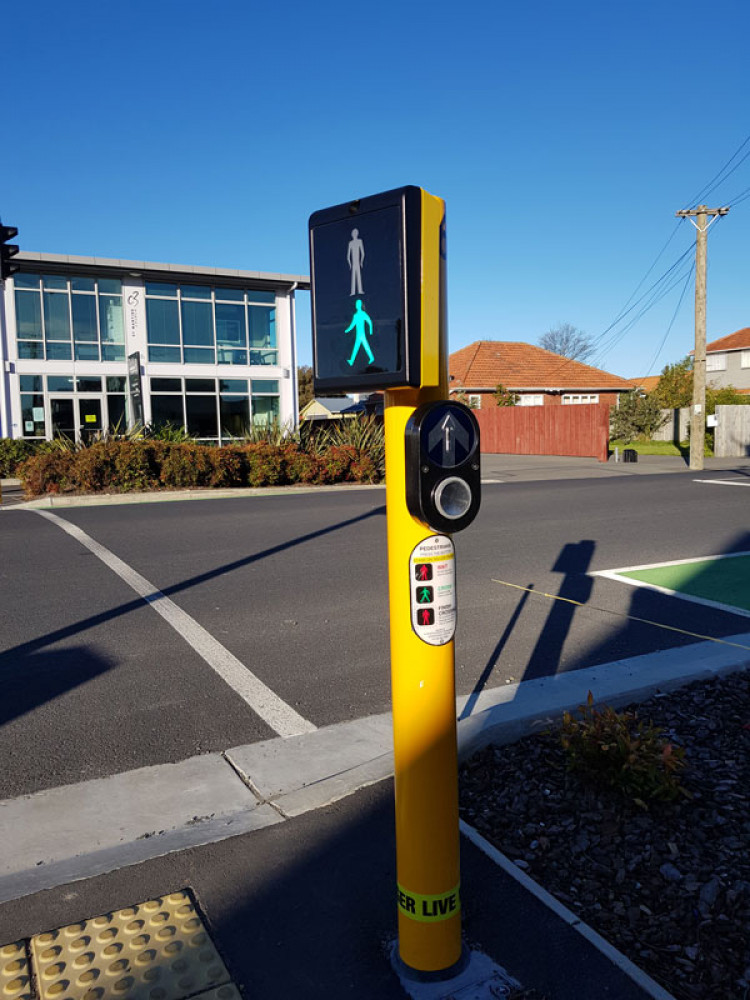
Nearside pedestrian signal display. (Photo: Gemma Dioni)
These crossings can be used by pedestrians and people riding bicycles and generally use far side signals. An example of a combined signalised crossing is shown in the photo below.
People on bicycles may receive advanced detection, and in some instances may only get advanced detection, which can be risky if the detectors fail. Like people waiting to cross on foot, people on bicycles should receive some confirmation that they have been detected and will get their chance to cross.
Further guidance and considerations to accommodate people cycling can be found in
Cycling Network Guidance: Signalised crossings
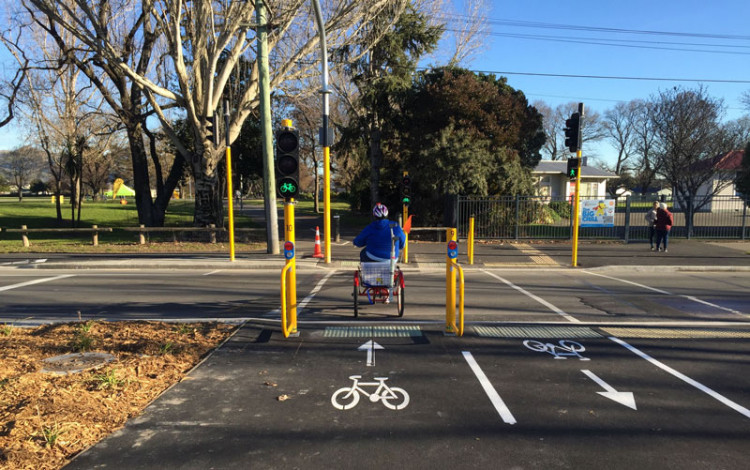
Pedestrian and cycle crossing with separate signals, Linwood Avenue in Christchurch. (Photo: John Lieswyn)
Historically, separate signal displays have been provided for people on foot and bicycle. However, in 2018 a combined signal face for pedestrians and cyclists commenced trials around New Zealand.
This reduces the amount of signal infrastructure to be provided as can be seen below. Note that people on bicycles may find a hold rail useful, however less infrastructure provides a wider uncluttered crossing.
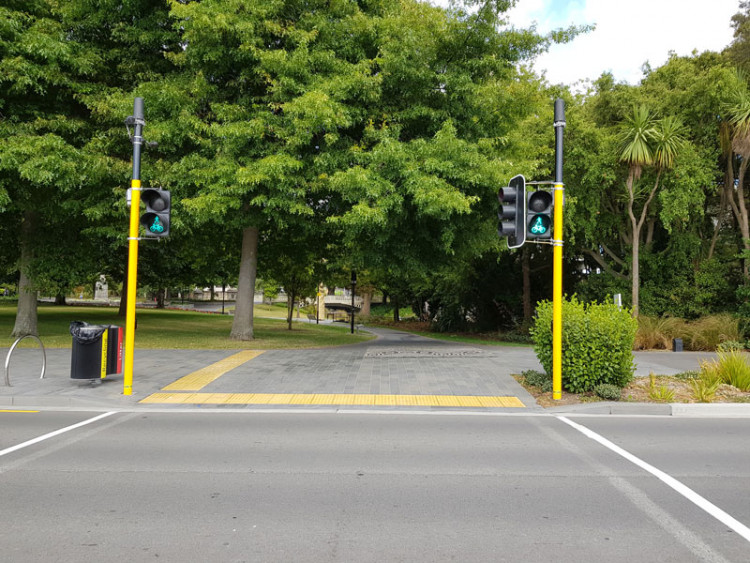
Combined pedestrian and cycle signal display under trial. (Photo: Gemma Dioni)
The designer will need to consider which is the most appropriate signal arrangement for the situation, so it is simple and effective. The context, length of crossing, detection and clearance times, as well as display details described in the table below will need to be considered.
Table: Choosing the right display type
|
Method |
Application |
Advantages |
Disadvantages |
|
Standard Farside Display |
Short crossings on two lane roads or for staggered crossings. |
Standard infrastructure. |
The green person symbol stops being displayed when people are still crossing and switches to a flashing red person symbol. Can create uncertainty for pedestrians crossing as unsure if they have time to cross and some drivers think the red person symbol allows them to filter through crossing pedestrians. |
|
Countdown Display |
Locations with high pedestrian crossing demand such as central city and suburban centres where people crossing are a priority. |
Purpose of the timers is to reduce the number of crossings made outside the pedestrian phase, thus increasing pedestrian safety and road efficiency. Highlights to the people crossing the time left to start or complete the crossing. |
Only suitable for farside signal displays. Only to be used where there are no conflicting motorised vehicle movements. As countdown relies on a fixed clearance period, the use of on-crossing detection is unsuitable. |
|
Nearside Display |
Standalone crossings on busy roads. Not for narrow streets as there is little need for the ability to extend the crossing time. |
Sends a clear message to pedestrians when they can start to cross and when they should not enter the road. After the green person symbol has ended, the solid red person symbol is shown straight away and the clearance period starts. Extends the clearance period if a pedestrian is still using the crossing. |
The display may not be visible to all pedestrians waiting to cross because the display being mounted at a position lower down the pole next to the pushbutton. Particularly an issue in central city locations. |
Consideration should also be given to providing consistent mid-block signal crossings along sections of corridors to minimise the risk of confusion for people using the crossings and the road corridor.
Pedestrian displays including how the green and red pedestrian signal aspects and countdown pedestrian signals should be installed and operated are outlined in the TCD Rule, 6.6.
Land Transport Rule: Traffic Control Devices 2004
Pedestrians, riders of mobility devices, and riders of wheeled recreational devices who are using the footpath must not enter the roadway when the flashing or steady red standing human figure is showing, and may enter the roadway when the green walking human figure is showing (Road User Rule, 3.5).
Pedestrians must not cross any other part of a roadway that is within 20m of the part controlled by traffic signals (Road User Rule, 11.3(2)).
Land Transport (Road User) Rule 2004
Typical layouts for mid-block traffic signals for pedestrians are provided in the TCD Manual Part 5 and reproduced below.

Typical layout for single stage mid-block signalised pedestrian crossings.
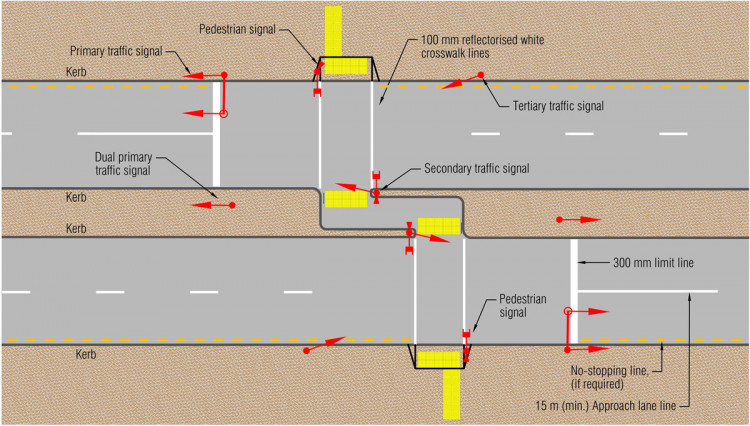
Typical layout for staggered mid-block signalised pedestrian crossings.
When a carriageway is more than 15m wide a two-stage layout should be provided. If the road width is between 11m and 15m a two-stage layout should be considered. A two-stage arrangement can include a chicane arrangement so that pedestrians are turned to face oncoming vehicles. This also means crossings on either side of the island/median can be activated at different times (staged crossings). If designing two-stage crossings, visors should be long enough and installed on each set of pedestrian displays so that pedestrians do not mistake one stage for another.
There are a number of supporting elements that should be considered during the concept and cost estimating stage to improve the safety for all road users and improve the level of service for people crossing the road. These include:
When considering the width of the mid-block signalised crossing the following should be considered:
As an example, if the path width approaching a crossing is 3.0m, then the queuing area and crossing width should be wider (up to twice as wide) to accommodate the expected groups of people wanting to cross the road or pass people queuing at the facility.
The TCD Manual Part 5 recommends a minimum width between crossing lines of 2.0m, with a desirable width of 2.5m. However, in areas of high pedestrian demand, wider crossing widths will be necessary. These need to remain as clear widths so additional space would be needed around traffic signal infrastructure and to take into account any shy space from pedestrian fencing.
TCD Manual Part 5 – Signalised pedestrian crossings
For two-stage crossings, the waiting area in the middle of the carriageway needs to be designed to hold the expected number of pedestrians in addition to devices such as mobility scooters, scooters, push chairs and (in the case of combined crossings) cyclists.
Walking speeds are an important consideration at signalised crossings. At traffic signals, designers should also be mindful of the following:
PNG: Physical space and walking speeds
Generally pedestrian displays move between red, green and flashing red. However, there are some variabilities, for example, many new signal installations include a countdown display in addition to the human figure signals.
Safe operation of signals requires high levels of pedestrian compliance so the signals should respond promptly to pedestrian demand. Different ways of improving signal responsiveness to pedestrians include:
The signal timings should allow for the maximum practical crossing time for pedestrians. The table below summarises ideal pedestrian timings.
Table: Pedestrian signal aspects
|
Symbol |
Meaning |
Ideal timings |
Minimum timings |
|
Steady red standing human figure
|
Do not step out on to the road. Wait by the kerb. |
The longest average waiting time should be 30 seconds to avoid pedestrians choosing their own gap and trying to cross. |
|
|
Green walking figure |
After checking it is safe to do so, walk across the road. |
The green walking pedestrian symbol should be displayed as soon as practicable after the push button is pressed. Provide sufficient time for all waiting pedestrians to enter the crossing. This depends on the depth of waiting space occupied. |
Five seconds (six seconds preferred). At shorter intervals, some pedestrians may start to cross and then turn back. |
|
Flashing red standing human figure |
Do not step out on to the road, but finish crossing if already on the road. |
A pedestrian who has just entered the roadway and is travelling at the 15th percentile speed (default 1.2 m/s) on the longest valid crossing route, should be able to reach the opposite kerb before the steady red standing human figure appears. |
|
Further guidance on traffic signal operations is available in the Austroads Guide to Traffic Management Part 9[4].
There are a number of methods for detection that offer advantages and disadvantages that are outlined in the table below.
The table describes the following detection methods:
![]() Table: Methods of detection [PDF, 178 KB]
Table: Methods of detection [PDF, 178 KB]
The table below summarises the key features of signal controlled crossings.
![]() Table: Design elements of signalised crossings [PDF, 169 KB]
Table: Design elements of signalised crossings [PDF, 169 KB]
Pedestrian push buttons are usually mounted on traffic signal poles. An example of a push button is shown below.
There are several key principles that should be followed when installing pedestrian push buttons at signalised intersections. Push buttons should have all the audible and tactile features specified in ‘AS 2353: 1999: Pedestrian push button assemblies’ and summarised in the following guidelines:
RTS 14 – Guidelines for facilities for blind and vision impaired pedestrians [PDF, 1.6 MB]
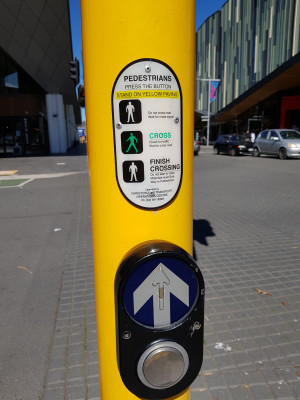
Pedestrian push button with explanatory placard. (Photo: Gemma Dioni)
Pedestrian push buttons should be:
Pedestrian push buttons should be easily accessible by all pedestrians. Some guidance is provided in Table 1 of the Tactile Indicator Installation Note (TAN #20-20), and in addition the push button should be:
[1] Corben, B. (2020). Integrating Safe System with Movement and Place for Vulnerable Road Users(external link), Austroads, AP-R611-20, p19
[2] PUFFIN (Pedestrian User Friendly Intelligent Crossing) pedestrian crossings are widely used in the United Kingdom and their use is endorsed by the UK Department for Transport. They are not defined as PUFFIN crossings in New Zealand, the correct terminology is mid-block signal-controlled pedestrian crossing that uses nearside signals.
[3] [4] See AGTM09 19 Guide to Traffic Management Part 9 Transport Control Systems – Strategies and Operations Appendix G.5.1(external link)